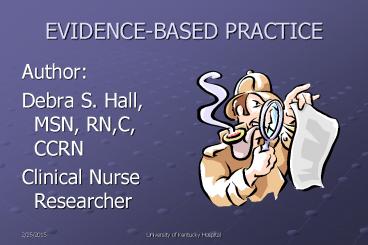EVIDENCE-BASED PRACTICE - PowerPoint PPT Presentation
Title:
EVIDENCE-BASED PRACTICE
Description:
A shift in the culture of providing healthcare away from basing decisions on ... Obstructive sleep apnea (Sonnad, et al., 2003) ... – PowerPoint PPT presentation
Number of Views:57
Avg rating:3.0/5.0
Title: EVIDENCE-BASED PRACTICE
1
EVIDENCE-BASED PRACTICE
- Author
- Debra S. Hall, MSN, RN,C, CCRN
- Clinical Nurse Researcher
2
AUTHOR
3
CONTENT
- Definition of Evidence-based practice (EBP)
- Effect of Evidence-based practice
- Implementation of Evidence-based practice within
a clinical setting
4
EVIDENCE-BASED MEDICINE
- A shift in the culture of providing healthcare
away from basing decisions on opinion, past
practice, and precedent toward making more use of
science, research, and - evidence to guide
- clinical decision-making
5
Evidence-based practice is a state of minda
constant process of inquiry.Why am I doing it
this way? Is there evidence that can guide me to
a better outcome?(Foster, 1999)
6
EVIDENCE-BASED PRACTICE (EBP)
- The conscientious and judicious use of current
best evidence to guide health care decisions for
improving patient outcomes. - Marita Titler, PhD, RN, FAAN
7
RESEARCH
- A systematic scientific process that generates
new knowledge or validates existing knowledge
8
RESEARCH UTILIZATION
- Research Utilization (RU) differs from
evidence-based practice (EBP) in that, although
RU also serves to improve the quality of patient
care, - it utilizes solely research
- findings as a basis of practice
- to improve patient care
9
QUALITY IMPROVEMENT
- The betterment or enhancement of a product or
service - This can be achieved by EBP, but is not limited
to it
10
PERFORMANCE IMPROVEMENT
- Focuses on the achievement of human performance
goals - Focuses on the performance of the individual and
person-specific goals
11
- Evidence-based practice in the clinical setting
requires the integration of - individual clinical expertise
- with the
- best available external clinical evidence from
systematic research
12
INDIVIDUAL CLINICAL EXPERTISE
- The proficiency and judgment that clinicians
acquire through clinical experience and clinical
practice leading to more effective and efficient
patient assessment and diagnoses
13
BEST AVAILABLE CLINICAL EVIDENCE
- Clinically relevant patient-centered research,
scientific evidence, empirical evidence,
institutional data, and external data that
indicate how to achieve patient outcomes that you
wish to achieve
14
EBP assists in -
- practicing based on the evidence (rather than
opinion) - Accepting clinical guidelines developed by other
disciplines - Developing indicator conditions in which the
management and performance of patient care create
a difference in patient outcomes
15
- The aim of evidence-based practice (EBP) is to
reduce wide variations in individual clinicians
practices, eliminating worst practices, and
enhancing best practices, thereby reducing costs
and improving - quality.
16
OUTCOMES MANAGEMENT
- Efficacy the results of an intervention applied
under ideal conditions (RCT) - Effectiveness the results of an intervention
applied in the real world fewer controls lack
of random assignment
17
EBP CHANGES THE FOCUS FROM PROCESS TO RESULTS
- What systems or problems are not allowing growth?
- What barriers are present that prevent you from
delivering the quality of care you, and your
staff, think is needed?
18
USE OF EBP IN ANALYSIS OF CARE ISSUES
- Use of specialty beds in patients for skin care
- Evidence supports use of some specialty beds only
for pulmonary problems
19
USING EBP TO EVALUATE THE QUALITY OF CARE
- Obstructive sleep apnea (Sonnad, et al., 2003)
- Cardiac Rehabilitation (Bitzer EM, Klosterhuis H,
Dorning H, Rose S., 2003) - Oncology oral care (Stricker Sullivan, 2003)
20
THE EBP PROCESS
- Link your use of evidence-based practice to a
process - May choose an existing process
- May choose another process commonly used in your
organization/institution
21
- Assess the need for change in current practice by
- including the stakeholders
- collecting internal data about current practice
- comparing internal/external data (benchmark)
- identifying your problem statement/desired state
22
- Link problems, interventions outcomes by
- using standardized classification systems
language - identifying potential interventions activities
- selecting outcome indicators
23
PROBLEM STATEMENT
- There is an increase in requests for nursing
staff to administer unfamiliar anesthetic and
sedative agents in the ICU area for procedures
which affect patient care and staffing.
24
DESIRED STATE
- Nursing staff will have guidelines for
administration of sedatives during procedures and
extended patient treatment and for care of such
patients in the critical care area
25
- Synthesize the best evidence by
- searching literature related to major issues
- critiquing weighing the evidence
- assessing the feasibility, benefits, and risks
26
- Design practice change by
- defining the proposed change
- identifying needed resources
- planning an implementation process
- defining outcomes
27
OUTCOME INDICATORS
- Data collected on administration of approved IVP
drugs by ICU RNs (e.g., frequency) - Anecdotal reports from staff on administration of
approved drugs - No negative patient outcomes with non-approved
drugs
28
- Implement evaluate the change in practice by
- pilot study demonstration
- evaluate process outcome
- decide to adapt, adopt, or reject practice change
29
- Integrate maintain change in practice by
- communicating recommendations to stakeholders
- staff education on changes in practice
- integrating changes into standards of practice
- monitoring the process outcomes
30
WHAT INFORMATION IS AVAILABLE ON THE WEB ON EBP?
- http//www.ahcpr.gov/
- www.cochranelibrary.com
- http//www.cche.net/usersguides/main.asp
- http//www.shef.ac.uk/scharr/ir/core.html































